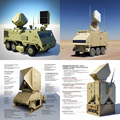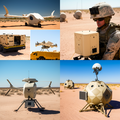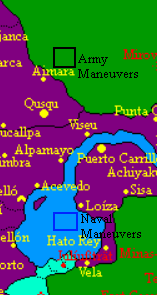Operation Sovereign Borders
Operation Sovereign Borders military exercise was held from 10.II.1717 AN to 24.II.1717 AN by military forces from the New Alexandrian, Constancian, and Suren Confederacy in the Keltian The Green near the cities of Aimara and Loiza. The exercise aimed to test military readiness and the integration of new technologies and was held in the continent of Keltia, with Nouvelle Alexandrie serving as host in the Regions of the Wechua Nation and Santander. The objective was to improve military readiness and coordination among nations participating in the Raspur Pact's Trans-Euran Command and Keltia Command. The exercise showcased the latest weapons technology such as the Vulcan Advanced Air Defense System, Future Infantry Combat System, Precision Air-Burst Rifle, JAV 110 Omega, and Aerial Defense Sentinel Swarm.
Background
Constancia and Nouvelle Alexandrie regularly hold military exercises and operations in the lands settled and obtained through Operation Paramount in the continent of Eura as part of regular readiness exercises for the Trans-Euran Command of the Raspur Pact. These lands were still prone to unrest even after the Pact's victory, with various groups and nomadic guerillas causing trouble for the Raspur Pact forces stationed there. Through these military exercises, the Raspur Pact forces aimed to maintain a high level of readiness and improve their ability to respond to any potential threats.
The Kapavian insurgency in the Suren Confederacy drew the concern of some lawmakers and military officials in Nouvelle Alexandrie, in particular after Floria deployed 60,000 troops to Suren with the insurgent forces causing widespread chaos and destruction. In response, the Surenid government accepted New Alexandrian advisers and trainers along with financial and technical aid to support Surenid efforts to fend off the insurgency. Through Operation Evergreen, Nouvelle Alexandrie provided military training, support, and advice to the Surenid forces, and also set up a reliable network of intelligence sharing between the two nations. This intelligence network helped the Surenid government to stay ahead of the insurgency, allowing them to anticipate their next moves and respond accordingly.
In light of these ongoing challenges, the government of Nouvelle Alexandrie suggested to the Trans-Euran Command that a military exercise be conducted among the nations in the Keltian Green. This exercise would be a collaborative effort between the New Alexandrian, Constancian, and Surenid military forces, coordinated by the Raspur Pact. The aim of the exercise was to improve military readiness and coordination between the nations, showcase the latest technological advancements and weapons platforms in the military arsenal, ensure the combat readiness of Raspur Pact forces, and engage in border security operations war games.
Purpose
The main objective of the military exercise was to enhance military readiness and coordination between the Trans-Euran Command and the Keltian Continental Theatre Command in the Raspur Pact. The participating countries were Nouvelle Alexandrie, Constancia, and the Suren Confederacy. The exercise also aimed to test and integrate new technologies and weapons platforms into military arsenals.
One of the key highlights of the exercise was the integration of cutting-edge weapons platforms and technologies. These included the:
- the Vulcan Advanced Air Defense System developed by Javelin Industries;
- the Future Infantry Combat System by Neridia Defense Industries;
- the Precision Air-Burst Rifle (PABR) by Rimarima Armaments;
- the JAV 110 Omega by Javelin Industries;
- the Aerial Defense Sentinel Swarm by Neridia Defense Industries and Sarbanes-Lopez CyberSecurity.
The Vulcan Advanced Air Defense System by Javelin Industries is a new and improved air defense system designed to protect against various air threats, including manned and unmanned aerial vehicles. The system features advanced sensors and tracking systems, as well as advanced missile technology, to ensure fast and effective engagement of targets. It also integrates the use of AI technology and the Tactical High-Energy Beam (Basilisk Beam), a directed-energy weapon air defense system that is a fiber laser that can destroy an airborne target within seconds of firing. The Vulcan Advanced Air Defense System is mobile or fixed and is composed of an air defense radar, a command and control unit, and two High Energy Laser systems.
The Future Infantry Combat System by Neridia Defense Industries is a state-of-the-art infantry combat system that improves the connectivity and combat effectiveness of infantry personnel. The system includes modernized body armor, a helmet with thermal, night vision, and flashlight capabilities, communication systems, and special headphones to enhance situational awareness and communication on the battlefield. The FICS additionally has full compatibility and connectivity with the Nouvelle Alexandrian Cyber-Electromagnetic Activities Visualization System and with the Panopticon Nexus.
The Precision Air-Burst Rifle (PABR) by Rimarima Armaments is a versatile and lethal weapon that combines the power of an assault rifle with the technology of a low-velocity cannon. The heart of the PABR lies in its air-burst munitions, small yet effective projectiles that explode above or beside targets concealed behind cover. This ensures maximum damage to the enemy while the weapon leverages the latest advancements in computer technology to set and fire the air-burst munitions with pinpoint precision. The combination of a short, maneuverable assault rifle and semi-automatic cannon provides soldiers with a dual-threat option, capable of taking out targets with traditional rifle fire or utilizing the air-burst function for unparalleled battlefield dominance.
The JAV 110 Omega by Javelin Industries is a highly advanced air-launched hypersonic boost-glide missile designed to attack heavily defended time-sensitive targets. The JAV 110 Omega is a smaller version of Javelin Industries' JAV 105 Willbreaker, a submarine-launched hypersonic boost-glide missile. The JAV 110 Omega was designed to be launched from aircraft, making it a versatile and widely deployable weapons platform. During Operation Sovereign Borders, the missile was used in simulated combat scenarios, allowing the militaries to evaluate its performance and determine its effectiveness in real-world conditions and against heavy air defenses. Javelin Industries has also developed a new version of the missile, the JAV 110-A to be deployed across a wider range of weapons platforms, making it even more versatile and widely deployable across the Raspur Pact militaries.
The Aerial Defense Sentinel Swarm (ADSS) by Neridia Defense Industries and Sarbanes-Lopez CyberSecurity is a sophisticated weapons program that leverages advancements in drone technology and artificial intelligence. The program utilizes a swarm of small, autonomous drones, equipped with high-resolution sensors and sophisticated communication systems, to provide situational awareness and intelligence on the battlefield. The drones are capable of working together to provide coordinated and synchronized support to ground troops, including reconnaissance, surveillance, and attack capabilities. The program also leverages advanced artificial intelligence algorithms to dynamically allocate tasks to individual drones, ensuring maximum efficiency and flexibility in complex and rapidly changing environments. The ADSS is designed to be able to connect and be fully compatible with the Future Infantry Combat System by Neridia Defense Industries and with the Nouvelle Alexandrian Cyber-Electromagnetic Activities Visualization System.
The exercise provided an opportunity to assess the performance of these new technologies and weapons platforms in real-world conditions and evaluate the overall performance of the participating militaries.
Precision Air-Burst Rifle (PABR) by Rimarima Armaments
Exercise
The military exercise was a comprehensive and complex undertaking that involved thousands of soldiers, hundreds of weapons systems, and numerous aircraft and naval vessels. The exercise was designed to simulate real-world combat scenarios and put the soldiers, weapons, and equipment to the test, allowing the military to assess their ability to work together and employ their capabilities effectively. The focus of the exercise was on conducting realistic combat scenarios that tested the soldiers' ability to work together and to use their weapons and equipment effectively. The exercise was also an opportunity to assess the performance of the new technologies and weapons platforms recently developed by industry and presented for evaluation by the Federal Forces of Nouvelle Alexandrie.
The land and land aviation portions of the exercise took place 93 miles northeast of the Wechua city of Aimara, in the Keltian Green. The Keltian Green was chosen for its rugged terrain and challenging environmental conditions, making it an ideal location to test the soldiers' ability to navigate and fight in difficult environments. It was also chosen because of the heavy presence of non-state armed groups, armed militias, or criminal gangs, with which forces did engage and had live fire skirmishes and engagements. The land portion of the exercise involved various combat scenarios, including ambushes, defensive operations, assaults, and close air support. The land aviation portion of the exercise also included testing capabilities of newly acquired aircraft and their ability to support ground troops and provide close air support. The more experimental amongst the systems assigned to the land exercises were placed with the Future Warfare Demonstration Troop, which included industry representatives and technicians, and which was then attached to the 5596th Armoured Car Squadron whilst deployed in the Green.
The sea and sea aviation portions of the exercise took place 112 miles southwest from the city of Loiza in the New Alexandrian Region of Santander. This location was selected due to its deep water and complex currents, making it an ideal environment to test the naval and sea aviation capabilities of the military. The sea portion of the exercise involved simulated naval engagements, including reconnaissance, surveillance, and attack scenarios. The sea aviation portion of the exercise focused on the testing of the newly acquired aircraft and their ability to provide air cover and reconnaissance support to the naval forces.
The Federal Support Corps, a component of the Federal Guard Service, was meanwhile set to demonstrate its proficiency by delivering stores (food, fuel, munitions) and equipment held by the National Qullqa System to the deployed formations, including into the Green.
Participants
The exercise involved units from different branches of the Federal Forces of Nouvelle Alexandrie, the Imperial Constancian Armed Forces, and the Popular Levy of the Suren Confederacy.
Units
 Federal Forces of Nouvelle Alexandrie
Federal Forces of Nouvelle Alexandrie
- 4th Command & Control Unit
- 1004th Corps Headquarters Company
- 613th General Support Regiment
- 614th Area Defence Regiment
- 615th Pioneer Regiment
- 616th Works & Maintenance Regiment
- 1st Special Forces Brigade (elements)
- 35th Jungle Brigade (elements)
- 559th Rapid Response Unit
- 5591st Airlanding Regiment
- 5592nd Parachute Regiment
- 5593rd Parachute Regiment
- 5594th (Airborne) Light Artillery Regiment
- 5595th (Airborne) Engineer Regiment
- 5596th Armoured Car Squadron
- Future Warfare Demonstration Troop (attached)
- Aerial Defense Sentinel Swarm Demonstration Team
- Experimental Vehicle Section
- Future Infantry Combat System Demonstration Team
- Designated Precision Air-Burst Rifle (PABR) Marksman
- Vulcan Advanced Air Defense System Demonstration Team
- Future Warfare Demonstration Troop (attached)
- Federal Air Defence Wing (Cardenas)
- F-17 Axarana x10
- F-18 Cyclone x1
- Federal School of Aviation (Parap)
- Fleet Station Command of the Post-Captain for the Port of Puerto Carrillo
- Isabella-class mine countermeasure ship x1
- Melusine-class Missile Boat x1
- Piriya-class coastal patrol ship x1
- Federal Support Corps (elements)
- 4th Command & Control Unit
 Visiting Allied Forces
Visiting Allied Forces
 Task Force Nord
Task Force Nord
- 2nd Taxiarchia (Brigade), Aerometaferomeni Merarhia (Airborne Division)
- Tercio de Extranjeros (elements), Legeóna ton Xénon Konstantinanoú (Constancian Foreign Legion)
- 4th Battalion, Reconnaissance Regiment, 1st Vanguard Division, 506th (Molivadia) Army
- Joint Assault Signal Party Sigma, Imperial Constancian Navy
- Joint Assault Signal Party Theta, Imperial Constancian Navy
- 503rd Section, Independent Brigade for Radio-intercept and Radio-technical Reconnaissance, Imperial Constancian Air Force
 Lashkar-e-Yazatá (elements)
Lashkar-e-Yazatá (elements)
Results
- Vulcan Advanced Air Defense System: Oh dear. Engaging a stray weather balloon proved an embarrassing challenge. At one point the system attempted to lock onto and engage Atos, the brightest body in the sky.
- Future Infantry Combat System: Showing some real potential here. Users had some gripes regarding the weight and not wholly intuitive interface system, but the overall functionality was rated as excellent. With a bit more refinement this system might easily mature into a competitor against the Pattern M1671 Combat System developed by Neridia Defense Industries for the Benacian market.
- Precision Air-Burst Rifle: Another doubtful first outing. Four examples of the type were provided for the designated marksman to evaluate. His feedback began with a terse suggestion that at least two of the prototypes are likely to be more dangerous to the person pulling the trigger than their intended target. Of the remainder, fired munitions appeared to suffer from a rapid loss of velocity on exiting the muzzle of the weapon, and of detonating at erratic points along the ballistic trajectory towards the target. Further work required to iron out the defects. Until then the heir to the concept of the Shirerithian boomist rifle will apparently be also burdened with a similar dubious reputation as well.
- Aerial Defense Sentinel Swarm: Promising in theory, but in practice, under field conditions, getting a large number of autonomous small UAVs to sync and operate in concert eluded the team tasked with demonstrating the technology. Utter calamity was at least averted by the drones returning to their launching point rather than dropping out of the skies.
- JAV 110 Omega: The Omega missile had been specially modified to be carried by an adapted F-18 Cyclone "deep strike fighter". Now this was a successful test, of a sort, certainly the village which housed smugglers dealing in Bassarid narcotics smuggled across the Green from Haifa is no longer the structurally intact cluster of fortified adobe compounds that it once was. The deficiency here is in the modifications required for the F-18 to carry the missile. Carrying a large hypersonic missile externally negated many of the perceived benefits of a stealth aircraft. Some further refinement of the concept may be in order.
Consequences of the Galem-Tar strike
An awkward moment for the Premier in his guise as Secretary of Defense. Whilst no-one would seriously deny that the Bassarid aligned village of Galem-Tar was anything other than a wretched hive of lawlessness, the decision to slam a hypersonic missile into said community was always bound to be a controversial one.
It seemingly did not occur to the mission planners that the inhabitants of the Green might, by this stage, have access to cellphone technology. After all, in an ungoverned territory how would they get a signal? Yet somehow they did, and in consequence photos and videos of smouldering ruins, charred bodies, and weeping children quickly spread all over the internet, and there was going to be hell to pay if the media decided to run with the story on the following morning.





